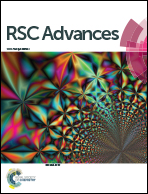FeCl2-catalyzed hydroboration of aryl alkenes with bis(pinacolato)diboron†
Abstract
The first ligand-free ferrous chloride catalyzed anti-Markovnikov hydroboration of un-activated aryl alkenes with bis(pinacolato)diboron (B2pin2) has been reported. The reactions proceeded smoothly with high regioselectivity for a large range of aryl alkenes with wide functional-group compatibility and low catalyst loading under mild conditions.


 Please wait while we load your content...
Please wait while we load your content...